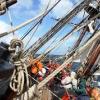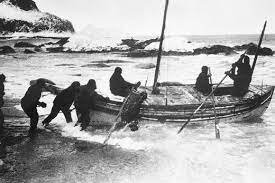-
Posts
1,296 -
Joined
-
Last visited
Content Type
Profiles
Forums
Gallery
Events
Everything posted by Bedford
-
Now you've got me worried, band saw, chain saw, circ saw, jig saw, scroll saw, super sharp model making saws and various hand saws and to date, no stitches in 61 years. What's around the corner!!! Mind you I have left a few drops claret in most jobs in one way or another. Glad your injury wasn't too serious though!
- 536 replies
-
- Quadrireme
- radio
-
(and 1 more)
Tagged with:
-
I think that's somewhat a shame, modern bureaucrats killing off old skills. Here in Aus the Sydney Heritage Fleet recently relaunched the steam ship John Oxley after 30 years on the hard. All hull plates have been replaced and RIVETED as per original, they did the same on the James Craig and S.T. Waratah has a riveted hull too. The governing bodies really should recognise and allow historically correct work on these vessels.
-
Keith, I'm biased but I don't reckon you can beat Ena. I've been aboard a few times and the details would really test you. Not to mention she is a museum ship now at the Australian National Maritime Museum.
-
Interestingly, in the book Hand, Reef and Steer by Tom Cunliffe he states that the jackyard topsail should be raised on the port side only. Although it will not be as efficient on the port tack it still works and the reasoning is simple bearing in mind he would be referring to English vessels with a job to do, short voyages and not many hands. The sail has to be raised and lowered on the lee side of the rig for obvious reasons and since doing so is a busy affair you don't want to have to leave it to tack away to avoid another vessel. Having it on the port side means you raise or lower it when on a starboard tack and therefore have right of way over other vessels.
-
Looking forward to more progress on this one
- 88 replies
-
- Australia II
- Finished
-
(and 2 more)
Tagged with:
-
I'm nobodys hydrological engineer (don't even think that's the right term) but I'd imagine that the oars sweeping in a fixed test like that will mostly stir the water into eddy currents and not result in much in the way of thrust but when on a floating boat they will work more as they're designed to which involves moving the boat rather than moving much water. I think it may surprise you.
- 536 replies
-
- Quadrireme
- radio
-
(and 1 more)
Tagged with:
-
I admire your determination and commitment to this, for what it's worth I think the 0.4 (last) stroke style is the best
- 536 replies
-
- Quadrireme
- radio
-
(and 1 more)
Tagged with:
-
Mate, this just keeps getting better! That is a huge slab of canvas to haul up from below and you raised it from the correct side too
-
I wouldn't worry about it looking top heavy, it would have been a very heavy boat and may have even had some ballast in the bilge. Shackleton put about 1 ton of rocks into the James Caird in order to sail it from Elephant Island to South Georgia after Endurance was crushed by ice and sank.
-
According to Iain Oughtred the rowlock should be 150-180mm above the thwart (6-7") so you can work back from there to set the height of the thwarts. I'm 6'2" and my rowlocks are at 200mm (they were 180 but the oars didn't reliably clear the gunwale so I raised them 20mm) and they are perfect. You should also be able to work backwards from the thwart height to achieve a comfortable floor height. For anyone who isn't familiar with Iain Oughtred, he is one of the premier small boat designers. world famous for his beautiful designs. As for the interior finish, it's not uncommon to paint below the sole and oil above. I agree that the difficulty in sanding to a smooth finish inside due to all the obstructions may have a negative effect if painted.
-
Beautiful workmanship as always Michael, nice to know you're still at it!
- 2,215 replies
-
Just found this build and I'm interested. If I may throw a curve ball re the walrus (I built a model of it as a kid) roundel. I learned recently that due to an American pilot attacking an Australian aircraft because he saw a solid red circle and assumed it to be Japanese the red inner circle was deleted. I'm not sure when this took place but you might like to look into it. Eventually the red circle was replaced by the now very well known red kangaroo but I've heard from a naval air commander that this happened straight away while others have said the roo wasn't introduced till after the war.
- 88 replies
-
- Australia II
- Finished
-
(and 2 more)
Tagged with:
-
One I taught my son was a 2kg Milo tin (think tin food container) with a press fit tin lid. Make some very small holes in the lid to facilitate air flow. Make a 6mm hole down very low to take a pvc tube of safe length. Take it outside. Place a half cup of flour in said tin with a lit Tee light candle Secure the lid, step back and just a gentle puff through the tube to stir up the flour. watch to see how high the lid goes. Best done when its a bit dark so you can see the flare up. Not that I'm recommending such activities
-
Keith, I had assumed a snug leather covering on the strops and of course that's impossible to recreate at this scale, have you considered just painting them in a suitable colour? A few heavy coats would pass for leather to a blind man on a galloping horse.
-
The fore and aft lines may be foot ropes. How were the wire strops covered to protect the wood work, bit hard to make out from the pics
-
Given the unusual heat you've been experiencing I suppose it's not unexpected for the wood to behave that way. I wonder though what happens when it returns to normal. Will that filler become an issue or will you seal the timber before it has a chance to re-hydrate?
-
Keith, you've done so much beautifully detailed work on this build that I'd forgotten about that interior work. It was a nice re-surprise if you will.
-
Allan, I'm no expert but the "anatomy of" book clearly shows belaying pin rails. Also, and again I can't speak with huge authority here but, the replica Bark Endeavour, on which I have sailed, is said to be among the most accurate ship replicas in the world, the original was launched in 1764, and you guessed it, belaying pins everywhere! HMS Victory launched 1765 and this is the original, not a replica. AT 33 seconds into this vid you see belaying pins!
-
There's been a bit more progress. The plan calls for two spiral staircases, one either side leading from the top of the kings cabin to the main deck but they don't include the doors which provide access below for the crew. According to the plan the hand rail across the front of the kings cabin carries from all the way starboard to a point which allows access to the stairway to the deck below on the port side therefore while the plan calls for two staircases it makes one redundant. The "anatomy of" book about this ship clearly shows there is only one staircase, to port, but there is access to the below decks on both sides. The kit doesn't call for any kind of hand rail for the spiral staircase but I'm working on a wooden hand rail. I bent some brass wire around the staircase following it's descent then found a round object of the same radius and laminated two pieces of walnut around it after soaking in boiling water. So far so good but a bit of work to do yet.
About us
Modelshipworld - Advancing Ship Modeling through Research
SSL Secured
Your security is important for us so this Website is SSL-Secured
NRG Mailing Address
Nautical Research Guild
237 South Lincoln Street
Westmont IL, 60559-1917
Model Ship World ® and the MSW logo are Registered Trademarks, and belong to the Nautical Research Guild (United States Patent and Trademark Office: No. 6,929,264 & No. 6,929,274, registered Dec. 20, 2022)
Helpful Links
About the NRG
If you enjoy building ship models that are historically accurate as well as beautiful, then The Nautical Research Guild (NRG) is just right for you.
The Guild is a non-profit educational organization whose mission is to “Advance Ship Modeling Through Research”. We provide support to our members in their efforts to raise the quality of their model ships.
The Nautical Research Guild has published our world-renowned quarterly magazine, The Nautical Research Journal, since 1955. The pages of the Journal are full of articles by accomplished ship modelers who show you how they create those exquisite details on their models, and by maritime historians who show you the correct details to build. The Journal is available in both print and digital editions. Go to the NRG web site (www.thenrg.org) to download a complimentary digital copy of the Journal. The NRG also publishes plan sets, books and compilations of back issues of the Journal and the former Ships in Scale and Model Ship Builder magazines.






